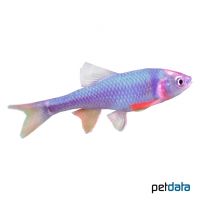Red Shiner (Cyprinella lutrensis)
| Red Shiner Cyprinella lutrensis | |
|---|---|
| Name | Red Shiner |
| Name Lat. | Cyprinella lutrensis |
| Synonym | Notropis lutrensis |
| Family | Minnows |
| Family lat. | Leuciscidae |
| Order | Carps |
| Order lat. | Cypriniformes |
| Origin | North America |
| Habitat | Streams, rivers, ponds |
| Diet | Omnivore |
| pH | 7.0-7.5 |
| Behavior | Peaceful |
| Keeping | Swarm |
| Care Level | Easy |
| Reproduction | Egg scatterer |
| Breeding | Moderately difficult |
| Life Span | 3 years |
| Protection | No |
| Metric Units | |
| Size | 8 cm |
| Temperature | 15-25 °C |
| Hardness | 10-20 °dH |
| Aquarium | ~ 150 l or pond |
| US Units | |
| Size | 3" |
| Temperature | 59-77 °F |
| Hardness | 178-356 ppm |
| Aquarium | ~ 40 gal or pond |
Distribution and habitat
The range of the American redfin sculpin is the midwestern and southern United States to northern Mexico. These undemanding fish live in schools in flowing and stagnant waters, such as streams, small rivers, oxbow lakes and ponds with muddy or sandy-pebbly bottoms.
Maintenance
The aquarium should have a dense border and background planting, with roots, which serve as a hiding and retreat possibility as well as offer a lot of free swimming space. A dark, sandy substrate covered with some foliage (e.g. sea almond leaves) and a weak current is ideal.
No ammonia, ammonium and nitrite must be detectable in the water, the nitrate value must not exceed 100 mg/l. To ensure the water quality and oxygen content, a filter adapted to the size of the aquarium and lighting for the species-appropriate day-night rhythm of the animals. Heating is not necessary at room temperature.
Diet
They are omnivores, feeding mainly on insects, small crustaceans, fish spawn and algae. The food supply consists of live or frozen cyclops, daphnia, mysis, artemia, mosquito larvae, etc., supplemented with high-quality dry food (granules, pellets), which is usually accepted without problems. In addition, they also need vegetable food, such as soft plant material (algae leaves), scalded spinach or dry food with high vegetable content (kelp, spirulina)
Only feed as much as will be eaten in a few minutes. A regular and varied diet promotes health and increases resistance
Behaviour and compatibility
They are lively and sociable fish that do not exhibit any aggressive or incompatible behaviors. At least 5, but preferably many more American Redfinorfen should be kept together. Socialization with other peaceful fish is well possible.
Generally, only mutually compatible fish species with similar water condition and water temperature requirements should be socialized.
Sex dimorphism
The sexes are difficult to distinguish. The males are somewhat slimmer, more strongly colored at spawning time and they have a spawning rash on the head.
Reproduction and breeding
In their native habitat, American redfin spawn between April and September. During the spawning period the females lay up to 16 spawning bands with about 70 eggs each between water plants or stones
The life expectancy is rarely more than 3 years.
Important
In the summer months it is possible to keep them in the pond. They are not hardy and therefore not suitable for year-round keeping in the garden pond. As soon as the water temperature drops below 15 °C, they should be transferred to a cold water aquarium for overwintering. In spring they can be returned to the pond.
The American redfin is not a native species and therefore special care should be taken not to release it into the wild (fauna adulteration!).
The well-being of the fish should be monitored regularly. The temperature should be checked daily, the pH, hardness and nitrate value at least every 14 days. A regular partial water change is recommended, even if the pollutant load has not yet reached the upper limit. Sudden changes in water quality should be avoided. Newly introduced fish must be accustomed slowly to the water in the aquarium
Further literature can be found in your pet store.
References
Text: Werner Winter; Image: petdata
Source: BMELV (1998): Tierschutzgutachten - Haltung von Zierfischen (Süßwasser); RIEHL & BAENSCH (2006): Aquarien Atlas Bd. 1, Mergus Verlag; ENGELMANN (2005): Zootierhaltung - Tiere in menschlicher Obhut: Fische; Harri Deutsch Verlag
- Gemäß § 21 Abs. 5 Tierschutzgesetz idgF
